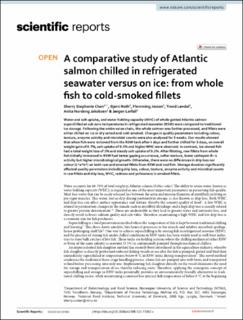| dc.contributor.author | Chan, Sherry Stephanie | |
| dc.contributor.author | Roth, Bjørn | |
| dc.contributor.author | Jessen, Flemming | |
| dc.contributor.author | Løvdal, Trond | |
| dc.contributor.author | Jakobsen, Anita Nordeng | |
| dc.contributor.author | Lerfall, Jørgen | |
| dc.date.accessioned | 2020-10-19T08:43:30Z | |
| dc.date.available | 2020-10-19T08:43:30Z | |
| dc.date.created | 2020-10-13T11:25:28Z | |
| dc.date.issued | 2020 | |
| dc.identifier.citation | Scientific Reports. 2020, 10 . | en_US |
| dc.identifier.issn | 2045-2322 | |
| dc.identifier.uri | https://hdl.handle.net/11250/2683539 | |
| dc.description.abstract | Water and salt uptake, and water holding capacity (WHC) of whole gutted Atlantic salmon superchilled at sub-zero temperatures in refrigerated seawater (RSW) were compared to traditional ice storage. Following the entire value chain, the whole salmon was further processed, and fillets were either chilled on ice or dry salted and cold-smoked. Changes in quality parameters including colour, texture, enzyme activity and microbial counts were also analyzed for 3 weeks. Our results showed that when fish were removed from the RSW tank after 4 days and further chilled for 3 days, an overall weight gain of 0.7%, salt uptake of 0.3% and higher WHC were observed. In contrast, ice-stored fish had a total weight loss of 1% and steady salt uptake of 0.1%. After filleting, raw fillets from whole fish initially immersed in RSW had better gaping occurrence, softer texture, lower cathepsin B + L activity but higher microbiological growth. Otherwise, there were no differences in drip loss nor colour (L*a*b*) on both raw and smoked fillets from RSW and iced fish. Storage duration significantly affected quality parameters including drip loss, colour, texture, enzyme activity and microbial counts in raw fillets and drip loss, WHC, redness and yellowness in smoked fillets. | en_US |
| dc.language.iso | eng | en_US |
| dc.publisher | Nature Research | en_US |
| dc.rights | Navngivelse 4.0 Internasjonal | * |
| dc.rights.uri | http://creativecommons.org/licenses/by/4.0/deed.no | * |
| dc.title | A comparative study of Atlantic salmon chilled in refrigerated seawater versus on ice: from whole fish to cold-smoked fillets | en_US |
| dc.type | Peer reviewed | en_US |
| dc.type | Journal article | en_US |
| dc.description.version | publishedVersion | en_US |
| dc.source.pagenumber | 12 | en_US |
| dc.source.volume | 10 | en_US |
| dc.source.journal | Scientific Reports | en_US |
| dc.identifier.doi | 10.1038/s41598-020-73302-x | |
| dc.identifier.cristin | 1839138 | |
| dc.description.localcode | Open Access This article is licensed under a Creative Commons Attribution 4.0 International License, which permits use, sharing, adaptation, distribution and reproduction in any medium or format, as long as you give appropriate credit to the original author(s) and the source, provide a link to the Creative Commons licence, and indicate if changes were made. The images or other third party material in this article are included in the article's Creative Commons licence, unless indicated otherwise in a credit line to the material. If material is not included in the article's Creative Commons licence and your intended use is not permitted by statutory regulation or exceeds the permitted use, you will need to obtain permission directly from the copyright holder. To view a copy of this licence, visit http://creativecommons.org/licenses/by/4.0/. | en_US |
| cristin.ispublished | true | |
| cristin.fulltext | original | |
| cristin.qualitycode | 1 | |

